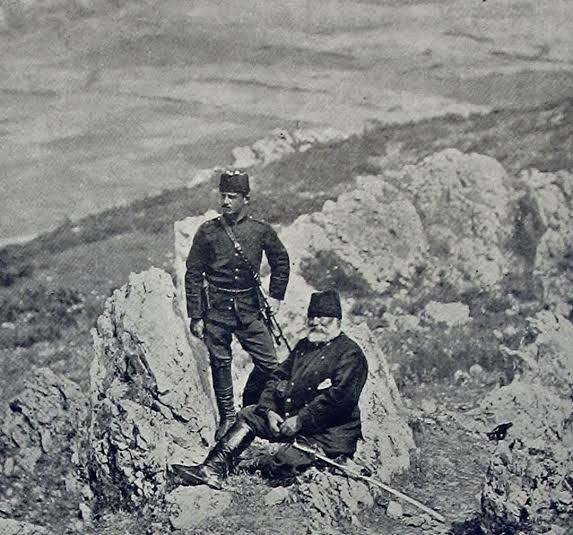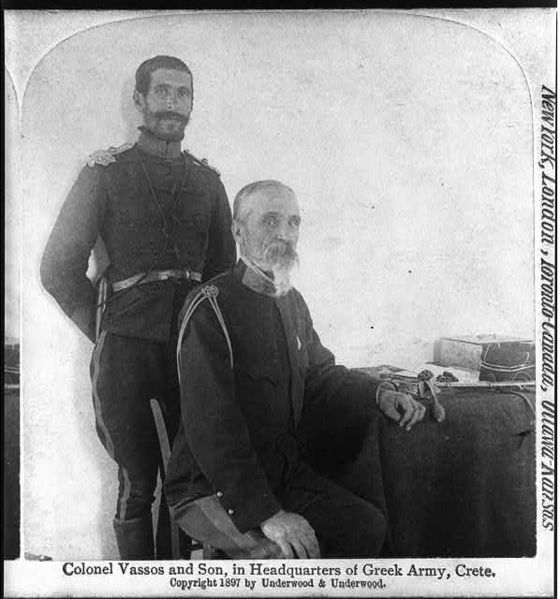Paşa first explained the plan for an Ottoman war with
Greece, as devised by Colmer Von der Goltz in 1886.
Then, he recounted how Ottoman Army forces were
actually deployed prior to the start of the war.//
Goltz Paşa in his Ottoman Army uniform, left, and in his
Prussian uniform. He returned to Turkey during World War I
and died in Iraq fighting the British in 1916.
In accordance with these considerations, Goltz Paşa proposed in his
plan that the Ottoman Army be assembled in Thessaly based on the
outline below:
-- one division would move to the Dava Pass from the sea and another
division would reconnoiter the border as far as Bey Değirmen and
defend that position;
-- the vanguard of the main force, made up of three regular divisions
and a cavalry division, would assemble at Bey Değirmen, on the
outskirts of Domenik and Çayhisar;
-- one division would form the right flank at Dişkata and reconnoiter
the border up the area around Meçve;
-- these six divisions would advance on Yenişehir (Larissa) in a
concentrated fashion and the attacking troops would hit the enemy
from the west.
Consequently, the aim of this attack would be to force the enemy to
to open a front on its west side and cut off its line-of-retreat toward
Agrafa on the way to Athens. Instead, the enemy would have to
retreat toward the Karaçayır swamps and the Osa Mountains.
This plan was not adopted as I have described it. Leaving just a few
soldiers at Yanya and giving up Preveze and Louros would have
required great determination and intellectual boldness. Consequently,
two strong divisions, with 35 battalions, were sent to Yanya and seven
divisions were assembled in Thessaly, rather than six. It is beneficial,
of course, to transport many forces so it would be wrong to say that
there were too many troops assembled in Thessaly.
The forces in Thessaly were distributed at the start of the war as
follows:
First Hayri Paşa division at the Çayhisar Pass
Second Neşat Paşa division at İskomba
Third Memduh Paşa division at Alasonya
Fourth Haydar Paşa division at Milona
Fifth Hakkı Paşa division at Dişkata
Sixth Mehdi Paşa division at Kozköy - Lefto Karya
Seventh Hüsnü Paşa division still en route
Thessaly battlespace (in red).
The reserve brigade under the command of Major General Mehmed
Paşa was at Alasonya, too. So, this distribution of forces is evidence
that the troop concentration deviated from Goltz Paşa's plan, because
rather than having a strong western front, the reserves were positioned
near the left flank and the center.
Because of political considerations, it was deemed impossible for us
to start the war prior to an enemy attack. So it was decided that it
would be logical for our reserves to assemble at the rear of Milona,
where it was most likely the enemy attack would come from. However,
it would have been a mistake for the bulk of our forces to be spread
along the border, across from the enemy, because we would be unable
to maneuver as we wished in the aftermath of the enemy's attack.

Ottoman Army Second Division commander Ömer Neşet Paşa
and aide.
This being the case, it would have be wise to just reconnoiter the border,
fortify certain important passes and points, while gathering the main
force in the rear in the Kesarya valley. In this way, in the event that the
enemy crossed the border we would be able to destroy the enemy by
a counterattack with our assembled forces. Unfortunately, the concern
about losing a few feet of land for a few hours or days served to veto
this idea and our ability to maneuver was lost.
it would have been a mistake for the bulk of our forces to be spread
along the border, across from the enemy, because we would be unable
to maneuver as we wished in the aftermath of the enemy's attack.
Ottoman Army Second Division commander Ömer Neşet Paşa
and aide.
This being the case, it would have be wise to just reconnoiter the border,
fortify certain important passes and points, while gathering the main
force in the rear in the Kesarya valley. In this way, in the event that the
enemy crossed the border we would be able to destroy the enemy by
a counterattack with our assembled forces. Unfortunately, the concern
about losing a few feet of land for a few hours or days served to veto
this idea and our ability to maneuver was lost.
As for the Greeks, they had become adersarial toward us because of
Crete. But even though they wanted war with us, they gave us as much
time as we wanted to assemble our forces. For a Greek soldier to
march overland from Greece's southernmost point to Thessaly would
take 15 days, under the best of circumstances. Figure in the inevitable
hinderences, and it would take the Greek army 20 days to assemble.
There were two months that passed between the "Vassos" detachment's
landing on Crete and the day of the declaration of war, giving us plenty
of time to gather our forces.
//Ed. note: Col. Timoleon Vassos led the Greek
detachment on to the island of Crete on 14 Februry 1897.
Greek invasion of Crete 1897 click here for details.//
Crete. But even though they wanted war with us, they gave us as much
time as we wanted to assemble our forces. For a Greek soldier to
march overland from Greece's southernmost point to Thessaly would
take 15 days, under the best of circumstances. Figure in the inevitable
hinderences, and it would take the Greek army 20 days to assemble.
There were two months that passed between the "Vassos" detachment's
landing on Crete and the day of the declaration of war, giving us plenty
of time to gather our forces.
//Ed. note: Col. Timoleon Vassos led the Greek
detachment on to the island of Crete on 14 Februry 1897.
Greek invasion of Crete 1897 click here for details.//

//END of PART III//

Hiç yorum yok:
Yorum Gönder